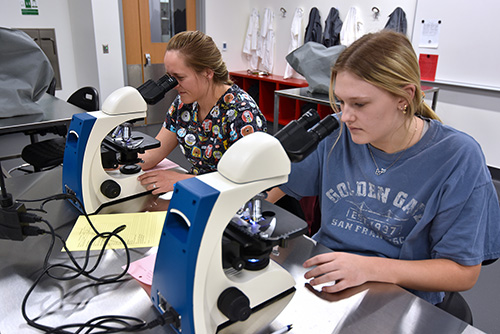NORFOLK, Neb. – Students and faculty are starting to feel at home in the new veterinary technology clinic and classroom facility at Northeast Community College. They moved into the building, located west of the Chuck Pohlman Ag Complex on E. Benjamin Ave., in January at the start of the Spring 2022 semester.
Dr. Michael Cooper, director of the veterinary technician program at Northeast, says one of the best features of the new facility is space – space for students to observe and learn, space for treatment and housing of animals, and space for expansion of the program which trains licensed vet techs, a high demand profession.
Cooper was the first full-time instructor in the Northeast program, started more than 30 years ago by the late Chuck Pohlman, Northeast’s first dean of agriculture. Originally a “veterinary care” program, Cooper said the program had four classes, Vet Care One, Two, Three and Four. Pohlman recruited three veterinarians practicing in Battle Creek – Dr. Larry Moenning, Dr. Dennis Hughes, and Dr. Paul Sundquist – as the first instructors. When the program proved to be viable, Cooper was hired in 1991.
“The first year was just learning how to teach,” Cooper said. “The vet care program was not accredited at the time.”
Cooper also taught classes like animal health and lambing management, which included “Lamb Watch” when students stayed overnight on the farm to observe the ewes lamb out.
“Some area veterinarians said if we really wanted to be taken seriously, we needed an accredited program,” Cooper said, “so we started working through the steps we needed to add it.”
The first need was space, and the program was expanded to the west bay in the old barn, and then to the east. One space remodeled was a former hog finish floor.
“It was next to the original surgery room, laboratory and dog kennel area,” Cooper explained. “During the winter, the warm humidity would drift over, hit the cooler air, and you would get brown streaks running down the wall. There was often a little “ode de swine” in the building.”
The first students in the accredited program were admitted in 1996 and graduated in 1998. Since then, hundreds of students have gone through the program. Many of them are working in area veterinary clinics, while some went on to become veterinarians. Others have gone into research, are working for pharmaceutical companies or in other areas of animal agriculture.
The new building is a long-time dream of Cooper’s, and he is excited about some of the facility’s unique features. Along with modern labs, an operating suite, treatment rooms, radiology, kennels and both indoor and outdoor exercise areas for animals, the new vet tech building also has classrooms, faculty offices and collaborative space, all under one roof. Previously, the lab and offices were on the main campus, while the animals and treatment areas were in the 100-year-old repurposed dairy barn.
“We’re all together now,” Cooper said. “It’s a short walk from the labs to the classrooms.”
Cooper said he recently helped students do an upper GI on a cat, and they also extracted three teeth.
“To do that in the old facility, we would have to get our scope out of the closet and put it all together and we’d have to get our dental machine from this room, over to the other. It was so cumbersome.”
“This is a legitimate small animal hospital, the way it’s set up and all the technical things available,” Cooper continued. “In the clinical pathology lab I have a bio safety hood that’s a level 2 which means you can handle some things like salmonella or listeria. So when we’re doing microbiology, the students learn how to work within a biosafety hood. Even if they go into research rather than a veterinary clinic, there are benefits.”
The new building also has more space for animals.
“You can’t replace experience,” he explained. “You can talk about how to restrain a dog, how to give an injection, how to put on a bandage, but until students actually do it, and more than likely not do it well, they don’t really learn. They need to put on a bandage, put the dog on the floor, watch the dog walk and watch the bandage fall off,” he said. “That’s what makes this program special, lots of hands-on experience.”
Students don’t just work with cats and dogs, either.
“We cover the whole gamut,” Cooper said. “We have exotics like ferrets and George the African spurred tortoise, rabbits and other rodents, and students work with the livestock on the Acklie Family College Farm.”
The new veterinary technology building is part of the Nexus campaign to provide modern facilities for agriculture students at Northeast. A dedication and open house for the building will be held on Tuesday, April 26. Public tours will be offered from 1-4 p.m., with the ribbon cutting ceremony at 1:30 p.m.
For more information on Northeast Community College’s Veterinary Technician program, visit northeast.edu/degrees-and-programs/veterinary-technology.
--###--
PHOTO CUTLINE
Jocilynn Behlen, Columbus (left), and Olivia Benes, Seward, veterinary technology students examine blood samples during a lab in the program’s new facility in Norfolk. A dedication and open house for the building will be held on Tuesday, April 26. Public tours will be offered from 1-4 p.m., with a ribbon cutting ceremony at 1:30 p.m.

